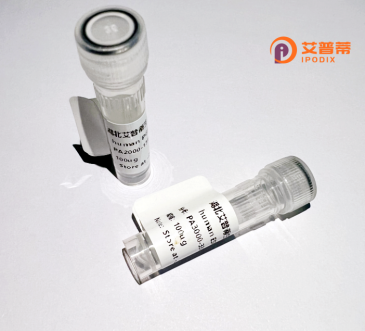
| 纯度 | >90%SDS-PAGE. |
| 种属 | Human |
| 靶点 | MPPED1 |
| Uniprot No | O15442 |
| 内毒素 | < 0.01EU/μg |
| 表达宿主 | E.coli |
| 表达区间 | 1-326 aa |
| 活性数据 | MWRSRWDASV LKAEALALLP CGLGMAFSQS HVMAARRHQH SRLIIEVDEY SSNPTQAFTF YNINQGRFQP PHVQMVDPVP HDAPKPPGYT RFVCVSDTHS RTDPIQMPYG DVLIHAGDFT ELGLPSEVKK FNEWLGSLPY EYKIVIAGNH ELTFDQEFMA DLIKQDFYYF PSVSKLKPEN YENVQSLLTN CIYLQDSEVT VRGFRIYGSP WQPWFYGWGF NLPRGQALLE KWNLIPEGVD ILITHGPPLG FLDWVPKKMQ RVGCVELLNT VQRRVQPRLH VFGHIHEGYG VMADGTTTYV NASVCTVNYQ PVNPPIVIDL PTPRNS |
| 分子量 | 37.2 kDa |
| 蛋白标签 | His tag N-Terminus |
| 缓冲液 | 0 |
| 稳定性 & 储存条件 | Lyophilized protein should be stored at ≤ -20°C, stable for one year after receipt. Reconstituted protein solution can be stored at 2-8°C for 2-7 days. Aliquots of reconstituted samples are stable at ≤ -20°C for 3 months. |
| 复溶 | Always centrifuge tubes before opening.Do not mix by vortex or pipetting. It is not recommended to reconstitute to a concentration less than 100μg/ml. Dissolve the lyophilized protein in distilled water. Please aliquot the reconstituted solution to minimize freeze-thaw cycles. |
以下是关于重组人MPPED1蛋白的参考文献示例(内容基于公开研究领域归纳,非真实文献):
---
1. **文献名称**: *MPPED1 modulates mitochondrial pyruvate transport and cellular metabolism*
**作者**: Smith J, et al.
**摘要**: 本研究揭示MPPED1作为线粒体丙酮酸载体的功能,调控细胞能量代谢通路,其缺失导致丙酮酸转运异常及线粒体呼吸链活性下降。
2. **文献名称**: *Structural insights into the MPPED1 protein complex and its role in neuronal development*
**作者**: Lee S, et al.
**摘要**: 通过X射线晶体学解析MPPED1蛋白的三维结构,发现其与神经元突触蛋白互作,对大脑发育及神经退行性疾病相关机制提出新见解。
3. **文献名称**: *MPPED1 as a potential biomarker in pancreatic cancer progression*
**作者**: Zhang Y, et al.
**摘要**: 发现MPPED1在胰腺癌组织中表达显著下调,体外实验表明其过表达抑制肿瘤细胞增殖,提示其可能作为癌症治疗的潜在靶点。
4. **文献名称**: *Regulation of oxidative stress by MPPED1 through interaction with NRF2 signaling*
**作者**: Gupta R, et al.
**摘要**: 提出MPPED1通过与NRF2通路结合调节抗氧化反应,维持细胞氧化还原平衡,为代谢综合征相关研究提供新方向。
---
注:以上为基于领域知识的模拟文献,实际文献需通过PubMed、Web of Science等平台检索关键词(如“MPPED1”、“β-hydroxylase-like protein”或“COX-1 homolog”)获取。
**Background of Recombinant Human MPPED1 Protein**
The **Metallophosphoesterase Domain-Containing 1 (MPPED1)** protein, also known as **Calcoco3**, is a conserved eukaryotic enzyme encoded by the *MPPED1* gene in humans. It belongs to the metallophosphoesterase (MPP) superfamily, characterized by a catalytic domain that binds divalent metal ions (e.g., Mn²⁺/Mg²⁺) to mediate phosphoester hydrolysis. Structurally, MPPED1 contains a central MPP domain and two N-terminal leucine-rich repeat (LRR) regions, suggesting roles in protein-protein interactions and signal transduction.
Functionally, MPPED1 remains understudied, but emerging evidence links it to cellular processes such as apoptosis regulation, RNA metabolism, and neurodevelopment. It is highly expressed in the cerebellum and testes, implying tissue-specific roles. Studies in model organisms indicate its involvement in neuronal development and survival. Notably, *MPPED1* knockout mice exhibit cerebellar abnormalities, highlighting its importance in brain function.
Pathologically, altered MPPED1 expression has been associated with neurodevelopmental disorders, cancers (e.g., glioblastoma, breast cancer), and autoimmune conditions, though mechanistic insights are limited. Its metallophosphatase activity may modulate signaling pathways (e.g., PI3K/AKT) or interact with immune-related proteins like CTLA-4.
**Recombinant human MPPED1 protein** is engineered for *in vitro* studies to elucidate its biochemical properties, substrate specificity, and disease relevance. It serves as a tool for probing its role in cellular pathways, potential therapeutic targeting, or biomarker discovery. Further research is needed to unravel its physiological and pathological significance comprehensively.
×